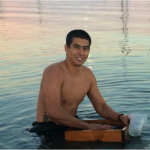Loving science for the challenge
by Christopher Bayne (San Diego State University undergraduate, ZENtern)
Field days have to be one of my favorite parts of science for two main reasons. The first reason is fairly obvious – we get to go out to the field site, which means getting some exercise, being in the sun, and working in the natural environment. You can’t beat that! The second reason is less intuitive. I really enjoy the challenges of fieldwork and problem solving. No matter how well protocols are planned and how many times you go over them, it seems that the smallest thing can turn into the biggest pain. Even though these problems can be time consuming and counterproductive, they keep you on your toes.
Along those lines, the ZEN predation intensity experiment comes to mind. The first time we deployed the experiment, which tested different materials as potential standardized prey to be used in experiments conducted by all of the ZEN partners, we used braided line threaded through different bait types. We separated each bait into separate bags for “quick and easy” deployment in the field. However, when we reached our field site we soon discovered that, when braided line goes into a bag, the mixture of moving around, getting wet, and Murphy’s law results in a knot so bad that you can barely distinguish one line from another. It just so happens that this occurred to six of our eight different bait types. What do we do?
We approached the problem like you do with so many other unexpected field issues. You accept it and just jump in headfirst. You approach the knot and honestly, there is no apparent advantage of coming at it at any certain way. You just begin trying to separate each line one at a time. You try different things: weaving the bait end through, loosening the most knotted sections, pulling the line through slowly. You swear you’ve undone hundreds of knots yet the ball of tangled string never looks as if any progress was made. Finally, you notice one looks as if it is almost loose. You put all your effort into that and get it out with this silent victory to yourself. Eventually they are all loose and you re-wrap them in a way that they will not get tangled up again. You think about what you could or should have done to avoid this mess. You finish up what needs to be done, knowing you are ready for whatever comes next.
In the end, the problem of the knotted line may be small but it is symbolic of the problems researchers face all the time. Little complications creep out of nowhere, completely unexpected. You try a million different solutions and begin to loose faith when nothing seems to work. If you have enough patience, the knot will eventually loosen and you will be victorious, swearing that you will never make that mistake again. This is why I have chosen to do science. It is challenging in so many ways. Learning the correct terminology, setting up experiments, finding solutions to unexpected problems – these are just some of the reasons why science is challenging and yet very rewarding.
Working on a project as large as ZEN adds an additional level of complexity in both coordinating large teams of people distributed all over the globe. This summer I will be travelling to Japan to work with the ZEN partners in both Akkeshi and Hiroshima. It is an amazing opportunity that not many undergraduates get to be a part of. I am looking forward to all of the challenges I will be facing this summer. I’m sure there will be more than a few but, if I’ve learned my lesson, tangled fishing lines will not be one of them!
Chris is a rising senior at San Diego State University pursuing his bachelor’s in biology and Japanese. Before starting the ZEN program Chris worked with Dr. Violet Compton Renick on her dissertation research examining the interactive effects of parasites and pesticides on killifish behavior. During the SDSU ZEN course Chris led a feeding experiment where he measured the grazing rates of several different types of San Diego mesograzer. This summer Chris will be traveling as part of his ZENternship to Japan to assist Drs. Massa Nakaoka and Massakazu Hori.




Comments are closed.